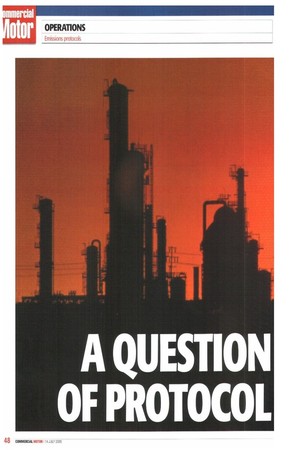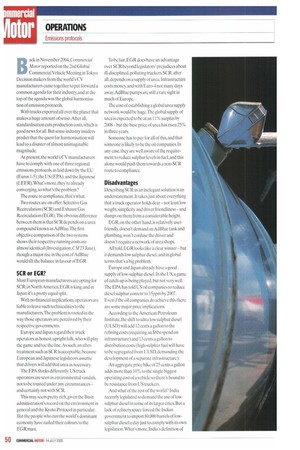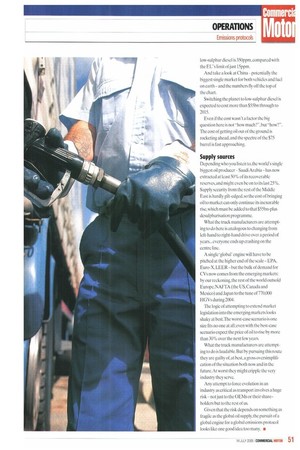A QUESTION OF PROTOCOL
Page 48

Page 50

Page 51

If you've noticed an error in this article please click here to report it so we can fix it.
Back in November 2004, Commercial Motor reported on the 2nd Global Commercial Vehicle Meeting in Tokyo. Decision makers from the world's CV manufacturers came together to put forward a common agenda for their industry, and at the top of the agenda was the global harmonisation of emission protocols.
With trucks exported all over the planet that makes a huge amount of sense.After all, standardisation cuts production costs, which is good news for all. But some industry insiders predict that the quest for harmonisation will lead to a disaster of almost unimaginable magnitude.
At present, the world's CV manufacturers have to comply with one of three regional emissions protocols, as laid down by the EU (Euros 1-5), the US (EPA). and the Japanese (LEER).What's more, they're already converging, so what's the problem?
The route to compliance, that's what.
Two routes are on offer: Selective Gas Recirculation (SCR) and Exhaust Gas Recirculation (EGR).The obvious difference between them is that SCR depends on a urea compound known as AdBlue.The first objective comparison of the two systems shows their respective running costs are almost identical (Investigation. CM 23 June), though a major rise in the cost of AdBlue would tilt the balance in favour of EGR.
SCR or EGR?
Most European manufacturers are opting for SCR; in North America,EGR is king; and in Japan it's a pretty equal split.
With no financial implications, operators are liable to leave such technicalities to the man ufacturers.The problem is rooted in the way those operators are perceived by their respective governments.
Europe and Japan regard their truck operators as honest, upright folk, who will play the game and toe the line. As such, an aftertreatment such as SCR is acceptable, because European and Japanese legislators assume that drivers will add that urea as necessary.
The EPA thinks differently. US truck operators are seen as environmental vandals. not to be trusted under any circumstances— and certainly not with SCR.
This may seem pretty rich, given the Bush administration's record on the environment in general and the Kyoto Protocol in particular. But the people who run the world's dominant economy have nailed their colours to the EGR mast. To be fair, EGR does have an advantage over SCR beyond legislators' prejudices about ill-disciplined, polluting truckers. SCR, after all, depends on a supply of urea. Infrastructure costs money, and with Euro-4 not many days away,AdBlue pumps are still a rare sight in much of Europe_ The cost of establishing a global urea supply network would be huge.The global supply of urea is expected to be at an 11% surplus by 2008 —but the base price of urea has risen 25% in three years.
Someone has to pay for all of this, and that someone is likely to be the oil companies. In any case, they are well aware of the requirement to reduce sulphur levels in fuel, and this alone would push them towards a non-SCR route to compliance.
Disadvantages
Describing SCR as an inelegant solution is an understatement. It takes just about everything that a truck operator holds dear—not least low weight, simplicity and driver friendliness — and dumps on them from a considerable height.
EGR,on the other hand, is relatively userfriendly, doesn't demand an AdBlue tank and plumbing, won't confuse the driver and doesn't require a network of urea shops.
All told, EGR looks like a clear winner—but it demands low sulphur diesel, and in global terms that's a big problem.
Europe and Japan already have a good supply of low-sulphur diesel. In the US, a game of catch-up is being played, but not very well. The EPA has told US oil companies to reduce diesel sulphur content to 15ppm by 2007. Even if the oil companies do achieve this there are some major price implications.
According to the American Petroleum Institute, the shift to ultra low sulphur diesel (ULSD) will add 12 cents a gallon to the refining costs (requiring an $8bn spend on infrastructure) and 13 cents a gallon to distribution costs (high-sulphur fuel will have to be segregated from LTESD, demanding the development of a separate infrastructure).
An aggregate price hike of 25 cents a gallon adds more than 10% to the single biggest operating cost of a vehicle so there's bound to be resistance from US truckers.
And what of the rest of the world? India recently legislated to demand the use of lowsulphur diesel in some of its larger cities. But a lack of refinery space forced the Indian government to import 80,000 barrels of lowsulphur diesel a day just to comply with its own legislation.What's more,India's definition of low-sulphur diesel is 35(1ppm, compared with the ELT's limit ofjustl5ppm.
And take a look at China —potentially the biggest single market for both vehicles and fuel on earth — and then umbers fly off the top of the chart.
Switching the planet to low-sulphur diesel is expected to cost more than $55bn through to 2015.
Even if the cost wasn't a factor the big question here is not "how much?", but "how?". The cost of getting oil out of the ground is rocketing ahead, and the spectre of the $75 barrel is fast approaching.
Supply sources
Depending who you listen to, the world's single biggest oil producer —Saudi Arabia — has now extracted at least 50% of its recoverable reserves, and might even be on to its last 25%. Supply security from the rest of the Middle East is hardly gilt-edged, so the cost of bringing oil to market can only continue its inexorable rise, which must be added to that $55bn-plus desulphurisation programme.
What the truck manufacturers are attempting to do here is analogous to changing from left-hand to right-hand drive over a period of years... everyone ends up crashing on the centre line.
A single 'global' engine will have to be pitched at the higher end of the scale— EPA, Euro-X,LEER— but the bulk of demand for CVs now comes from the emerging markets: by our reckoning, the rest of the world outsold Europe,NAFTA (the US, Canada and Mexico) and Japan to the tune of 770,000 1-1GVs during 2004.
The logic of attempting to extend market legislation into the emerging markets looks shaky at best.The worst-case scenario is one size fits no one at all; even with the hest-case scenario expect the price of oil to rise by more than 30% over the next few years.
What the truck manufacturers are attempting to do is laudable. But by pursuing this route they are guilty of, at best, a gross oversimplification of the situation both now and in the future. At worst they might cripple the very industry they serve.
Any attempt to force evolution in an industry as critical as transport involves a huge risk—not just to the OEMs or their shareholders but to the rest of us, Given that the risk depends on something as fragile as the global oil supply, the pursuit of a global engine for a global emissions protocol looks like one good idea too many. •










































































































































































































